Sedimentary rocks can be categorized into three groups based on sediment type. Most sedimentary rocks are formed by the lithification of weathered rock debris that has been physically transported and deposited. During the transport process, the particles that make up these rocks often become rounded due to abrasion or can become highly sorted. Examples of this type of sedimentary rock include conglomerate and sandstone. Scientists sometimes call this general group of sedimentary rocks clastic. The remaining types of sedimentary rocks are created either from chemical precipitation and crystallization, or by the lithification of once living organic matter. We identify these sedimentary rocks as being non-clastic.
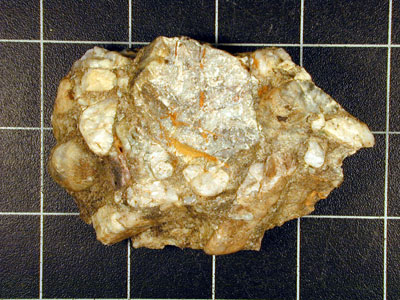
Figure 10f-1: Conglomerate.

Figure 10f-2: Sandstone.
All sedimentary rocks are lithified into some collective mass. Lithification is any process that turns raw rock sediment into consolidated sedimentary rock. The process of lithification usually produces identifiable layering in these type of rocks (Figure 10f-3). Lithification can occur by way of:
- Drying and compaction.
- Oxidation of iron and aluminum.
- Precipitation of calcium and silica.
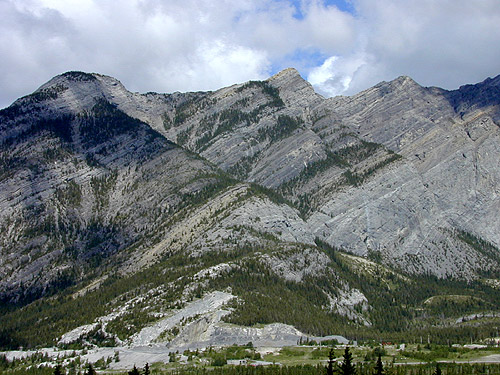
Figure 10f-3: Dipping sedimentary layers of rock, Rocky Mountains, Canada.
The classification of clastic sedimentary rocks is based on the particle types found in the rock. Some types of clastic sedimentary rocks are composed of weathered rock material like gravel, sand, silt, and clay. Others can be constructed from the break up and deposition of shells, coral and other marine organisms by wave-action and ocean currents. Table 10f-1 describes some of the main types of clastic sedimentary rocks.
Table 10f-1: Clastic sedimentary rocks.
| Name of Rock | Fragment Type |
| Breccia (Image Link) | Coarse Fragments of Angular Gravel and Rocks |
| Conglomerate | Coarse Fragments of Rounded Gravel and Rocks |
| Sandstone | Sand Sized Particles that are 90% Quartz |
| Arkose | Sandstone composed of 25% Feldspar Grains |
| Shale | Clay Particles |
| Siltstone | Silt Particles |
| Mudstone | Mixture of Clay and Silt |
| Limestone | Mixture of Shells, Coral, and Other Marine Skeletons |
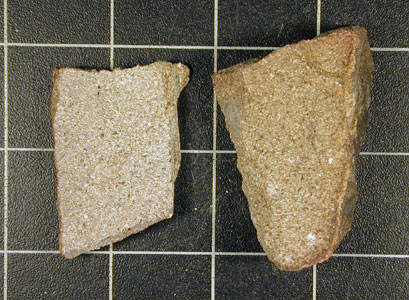
Figure 10f-4: Arkose.
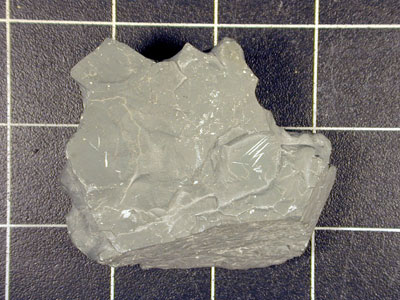
Figure 10f-5: Shale.
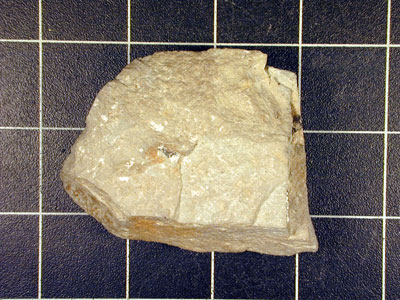
Figure 10f-6: Siltstone.

Figure 10f-7: Limestone.
Earlier it was suggested that there were two types of non-clastic sedimentary rocks. One group forms through the chemical precipitation and crystallization of elements and compounds from solution. Elements such as calcium, sodium, potassium, and magnesium are commonly released into the environment through a variety of chemical weathering processes. These elements can then become dissolved into aqueous solutions that are often transported via runoff, stream flow, or groundwater flow. If this solution enters a basin environment where evaporation exceeds precipitation and in-flow, sedimentary evaporites can form because of the loss of water from the solution.
The oceans are almost saturated with dissolved calcium carbonate. This compound originates from the shells of a variety of marine organisms that use it for the construction of shells and other hard body parts. Because these organisms are surrounded in a solution, some of the calcium carbonate dissolves into the ocean waters. Under the right circumstances the dissolved calcium carbonate can precipitate out forming chemically created limestone deposits. The formation of dolomite involves the chemical modification of limestone deposits by a magnesium rich solution.
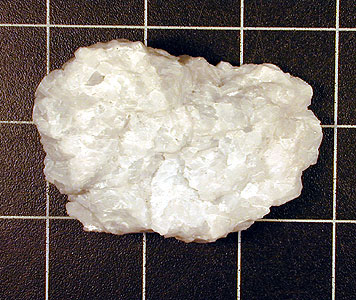
Figure 10f-8: Dolomite.
The following table describes some of the common forms of chemical precipitated sedimentary rocks.
Table 10f-2: Sedimentary rocks formed as chemical precipitates.
| Name of Rock | Precipitate Type |
| Halite | Sodium and Chlorine |
| Gypsum | Calcium, Sulfur, and Oxygen |
| Silcretes | Silica |
| Ferricretes | Iron |
| Limestone | Calcium Carbonate |
| Dolomite | Calcium Magnesium Carbonate |
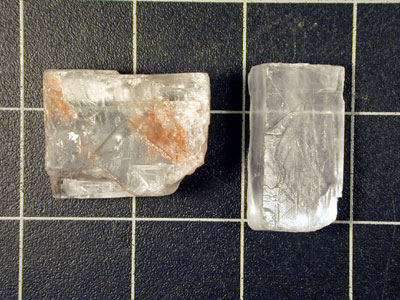
Figure 10f-9: Halite.

Figure 10f-10: Gypsum.
Several types of sedimentary rocks are formed from the lithification of once living organisms. Limestone deposits can be formed by the direct lithification of coral reefs, marine organism shells, or marine organism skeletons. Chalk is a particular variety of limestone that is composed of the skeletons of marine microorganisms like forminifera. Coal and lignite are the lithified remains of plants.

Figure 10f-11: Chalk.

Figure 10f-12: Coal.